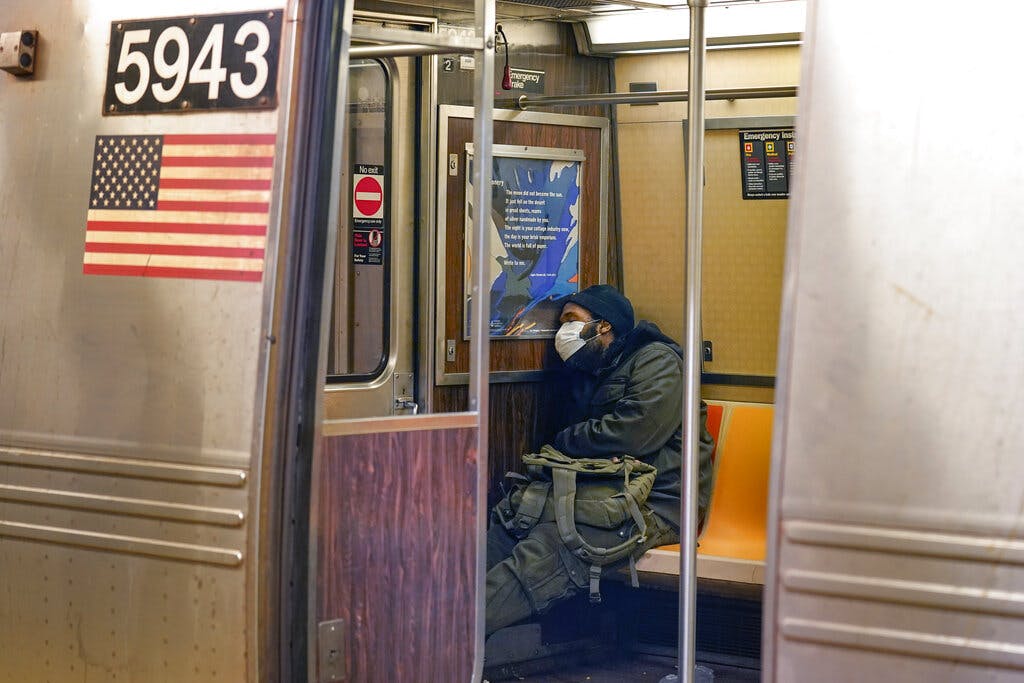Homelessness in the Subways Threatens New York’s Post-Covid Revival
Few American cities are as dependent on public transportation as New York. When subways and train stations function as daytime homeless shelters, the appeal of going in to work diminishes.

Homelessness, in New York, is a social problem that never gets fixed so much as redefined for each new era. Under Mayor Bloomberg, Occupy Wall Streeters held up homelessness as evidence of the scourge of income inequality. Mayor de Blasio’s difficulties handling homelessness exemplified progressive incompetence for many New Yorkers. And with Mayor Adams, the homelessness debate is intertwined with the debate about how to come back from Covid.
“Do really I need to go in today?” Every morning, thousands of New York metro residents ask themselves that question, one utterly decisive for the city’s future.
The New York economic model is built on busyness, not just density. New York is not the only city dealing with the economic consequences of the shift to working from home. Yet few American cities are as dependent on public transportation as New York. When subways and train stations function as daytime homeless shelters, the appeal of going in diminishes.
Riding New York City transit has, at times, been seen as a unique civic ritual. Sharing a subway car with Hasidic Jews, Latino construction workers, old Chinese women, investment bankers, and charter school students from the South Bronx: Where else but in America would you have an experience like that? How many European tourists returned from their trip to New York and reported back, based on what they saw riding the subway, that the American Dream is alive and well?
But it is unpleasant to share a subway car with a disheveled homeless man, muttering obscenities to himself and staring directly at you throughout the entire ride. No matter how many times you have that experience without any serious harm befalling you, it remains objectionable. Why does the city let this happen? He doesn’t seem to be getting any better. I certainly don’t need this.
Subway ridership now stands at about 60 percent of where it was pre-pandemic and transit crime is up. Homelessness’ contribution to rates of serious crime is hard to evaluate precisely. But its effect on the experience of disorder is definitive.
Standards of disorder can, to a degree, vary between communities and individuals. Some mentally ill people behave in erratic ways that their families and neighbors know to be harmless. But cities are communities of strangers. Packing in hordes of strangers in dense conditions requires a level of trust and the shared observance of common norms.
For many, working from home elevated their standards for public order. Working from the office has become more of a question of consumer choice. There are many benefits to going in, but also costs — and not only of a financial nature. In that assessment, encounters with people with untreated schizophrenia and panhandling that used to form part of the background landscape have been foregrounded.
To be clear, there is no evidence that homelessness increased during the pandemic. The broader, citywide homeless count of sheltered homelessness ticked down somewhat throughout the late de Blasio years, then hit a plateau late last summer. Since then, the sheltered homeless census has been holding steady at around 45,000 to 50,000. The number of unsheltered homeless — a far more inexact estimate, particularly during Covid — is officially 2,400. Those individuals are mainly concentrated in Manhattan and the transit system.
The Adams administration claims to be on it. The “Subway Safety Plan,” has reportedly moved over one thousand people from the transit system into shelter since February. Through an additional investment of $170 million in street outreach and other targeted programs, Mr. Adams pledges to keep the pressure on throughout the next fiscal year. We’ll see if this commitment yields results.
The gospel of inclusivity holds that public places, such as a park or subway car, are for everyone, and the presence of homeless people should in no way function as a deterrent to anyone else’s use of that space. Perhaps encountering homelessness can even be a good thing, instructive about poverty and injustice.
In practice, though, parks overrun by tent encampments are used only by the homeless. The broader public makes other accommodations. People will put up with more on the subway than they would in a park because they have to: for many, riding the subway is necessary in a way that visiting parks is not. But as a confined space, standards of order should be much higher on the subway than in a park.
When appropriate standards of public order aren’t met, those with maximum freedom will move to Florida and others with moderate freedom will stay in the region but work from home. Those without the luxury of choice must simply muddle through, wondering what they ever did to their city to deserve to be treated like this.

